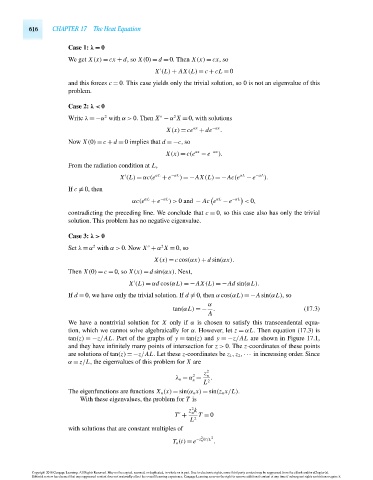Page 636 - Advanced_Engineering_Mathematics o'neil
P. 636
616 CHAPTER 17 The Heat Equation
Case 1: λ = 0
We get X(x) = cx + d,so X(0) = d = 0. Then X(x) = cx,so
X (L) + AX(L) = c + cL = 0
and this forces c = 0. This case yields only the trivial solution, so 0 is not an eigenvalue of this
problem.
Case 2: λ< 0
2
2
Write λ =−α with α> 0. Then X − α X = 0, with solutions
αx
X(x) = ce + de −αx .
Now X(0) = c + d = 0 implies that d =−c,so
αx
X(x) = c(e − e −αx ).
From the radiation condition at L,
X (L) = αc(e αL + e −αL ) =−AX(L) =−Ac(e αL − e −αL ).
If c = 0, then
αc(e αL + e −αL )> 0 and − Ac e αL − e −αL
< 0,
contradicting the preceding line. We conclude that c = 0, so this case also has only the trivial
solution. This problem has no negative eigenvalue.
Case 3: λ> 0
2
2
Set λ = α with α> 0. Now X + α X = 0, so
X(x) = c cos(αx) + d sin(αx).
Then X(0) = c = 0, so X(x) = d sin(αx).Next,
X (L) = αd cos(αL) =−AX(L) =−Ad sin(αL).
If d = 0, we have only the trivial solution. If d = 0, then α cos(αL) =−A sin(αL),so
α
tan(αL) =− . (17.3)
A
We have a nontrivial solution for X only if α is chosen to satisfy this transcendental equa-
tion, which we cannot solve algebraically for α. However, let z = αL. Then equation (17.3) is
tan(z) =−z/AL. Part of the graphs of y = tan(z) and y =−z/AL are shown in Figure 17.1,
and they have infinitely many points of intersection for z > 0. The z-coordinates of these points
are solutions of tan(z) =−z/AL. Let these z-coordinates be z 1 , z 2 ,··· in increasing order. Since
α = z/L, the eigenvalues of this problem for X are
z 2
2 n
λ n = α = .
n 2
L
The eigenfunctions are functions X n (x) = sin(α n x) = sin(z n x/L).
With these eigenvalues, the problem for T is
2
z k
n
T + T = 0
L 2
with solutions that are constant multiples of
2
T n (t) = e −z n kt/L 2 .
Copyright 2010 Cengage Learning. All Rights Reserved. May not be copied, scanned, or duplicated, in whole or in part. Due to electronic rights, some third party content may be suppressed from the eBook and/or eChapter(s).
Editorial review has deemed that any suppressed content does not materially affect the overall learning experience. Cengage Learning reserves the right to remove additional content at any time if subsequent rights restrictions require it.
October 14, 2010 15:25 THM/NEIL Page-616 27410_17_ch17_p611-640

